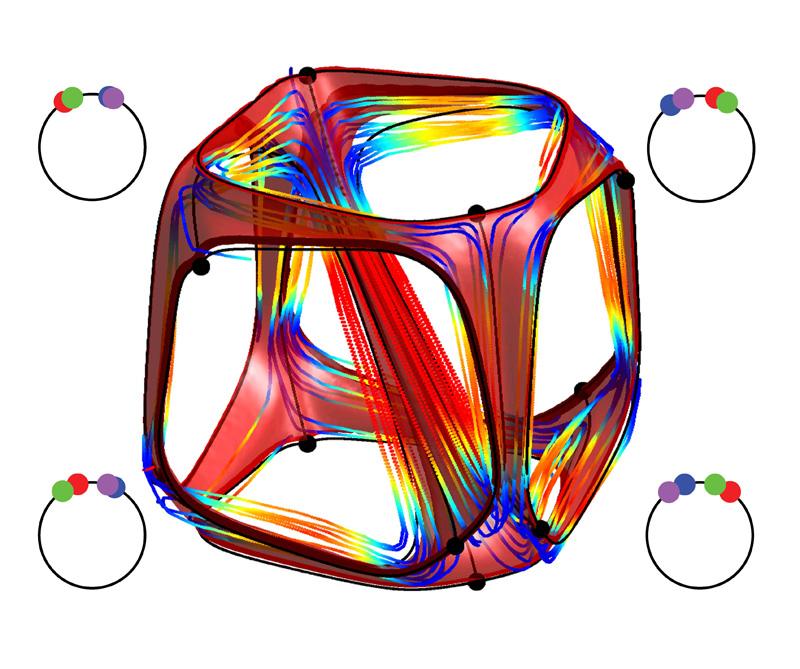June 5, 2007 -- When signals in complex systems — like hearts and brains — go haywire, dangerous conditions, such as irregular heartbeats and epileptic seizures, can develop. Researchers are seeking new ways to control such systems without burning them out.
A team of researchers in chemical engineering at the University of Virginia and in mathematics at Hokkaido University has developed a new method for engineering the behavior of complex dynamic systems made up of large numbers of individual components. They have demonstrated that mild signals can be effective in changing the behavior of a system of components. No such methodological approach existed previously.
In their experiments, the researchers applied a weak feedback signal to a rhythmic chemical system. By changing the feedback signal, the researchers were able to direct the system to change its activity — to spontaneous synchronization, desynchronization or cluster formation, which are patterns found in biological systems.
The experiments suggest that these signals may be used either to tune essential behavior — what pacemakers do to regulate an irregular heartbeat — or alter pathological behavior — which is what deep-brain “anti-pacemakers” do to stop the tremors caused by Parkinson’s or other diseases. In such applications, a mild control is ideal because it can tune the system to the desired behavior without destroying its fundamental nature. Mild controls also have the potential to reduce side effects and increase the battery life of medical devices.
“You’re trying to gently steer the system to go where you want it to go,” said John L. “Jack” Hudson, Wills Johnson Professor in the Department of Chemical Engineering at the University of Virginia’s School of Engineering and Applied Science. “Sometimes you want to create order in the system and sometimes you want to destroy that order. The challenge is to dial up complex structures with mild inputs in order to change the system’s behavior.”
The scientists’ combined theoretical and experimental work offers a simple, yet flexible engineering method that may have potential applications in various fields, including communications, systems biology, chemical reaction engineering and medicine, where this research might eventually be used to improve existing treatments and develop new ones for tremors or seizures, among other chronic conditions.
This research was published online May 24 in Science Express, on the Web site of the prestigious journal Science, which is used to highlight important papers accepted for publication by the journal. The paper also will appear in the upcoming print edition of Science.
Along with Hudson, two of the researchers — István Z. Kiss, research scientist; and Craig G. Rusin, a doctoral student — are in the Department of Chemical Engineering at U.Va.’s School of Engineering and Applied Science. The fourth author, Hiroshi Kori, is a research associate in the Department of Mathematics, Hokkaido University, in Sapporo, Japan.
Their paper, titled “Engineering complex dynamical structures: sequential patterns and desynchronization,” is available online at http://www.sciencexpress.org.
For more information, call Jack Hudson at (434) 924-6275, or contact him by email at Hudson@virginia.edu.
A team of researchers in chemical engineering at the University of Virginia and in mathematics at Hokkaido University has developed a new method for engineering the behavior of complex dynamic systems made up of large numbers of individual components. They have demonstrated that mild signals can be effective in changing the behavior of a system of components. No such methodological approach existed previously.
In their experiments, the researchers applied a weak feedback signal to a rhythmic chemical system. By changing the feedback signal, the researchers were able to direct the system to change its activity — to spontaneous synchronization, desynchronization or cluster formation, which are patterns found in biological systems.
The experiments suggest that these signals may be used either to tune essential behavior — what pacemakers do to regulate an irregular heartbeat — or alter pathological behavior — which is what deep-brain “anti-pacemakers” do to stop the tremors caused by Parkinson’s or other diseases. In such applications, a mild control is ideal because it can tune the system to the desired behavior without destroying its fundamental nature. Mild controls also have the potential to reduce side effects and increase the battery life of medical devices.
“You’re trying to gently steer the system to go where you want it to go,” said John L. “Jack” Hudson, Wills Johnson Professor in the Department of Chemical Engineering at the University of Virginia’s School of Engineering and Applied Science. “Sometimes you want to create order in the system and sometimes you want to destroy that order. The challenge is to dial up complex structures with mild inputs in order to change the system’s behavior.”
The scientists’ combined theoretical and experimental work offers a simple, yet flexible engineering method that may have potential applications in various fields, including communications, systems biology, chemical reaction engineering and medicine, where this research might eventually be used to improve existing treatments and develop new ones for tremors or seizures, among other chronic conditions.
This research was published online May 24 in Science Express, on the Web site of the prestigious journal Science, which is used to highlight important papers accepted for publication by the journal. The paper also will appear in the upcoming print edition of Science.
Along with Hudson, two of the researchers — István Z. Kiss, research scientist; and Craig G. Rusin, a doctoral student — are in the Department of Chemical Engineering at U.Va.’s School of Engineering and Applied Science. The fourth author, Hiroshi Kori, is a research associate in the Department of Mathematics, Hokkaido University, in Sapporo, Japan.
Their paper, titled “Engineering complex dynamical structures: sequential patterns and desynchronization,” is available online at http://www.sciencexpress.org.
For more information, call Jack Hudson at (434) 924-6275, or contact him by email at Hudson@virginia.edu.
Media Contact
Article Information
June 5, 2007
/content/researchers-find-new-way-engineer-complex-systems-creating-complex-dynamics-simple-rhythms

